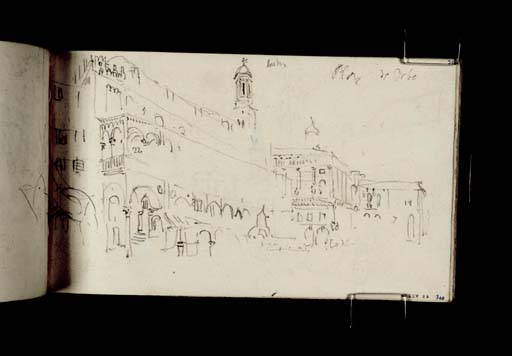Joseph Mallord William Turner The Piazza delle Erbe, Padua 1819
Image 1 of 2
Joseph Mallord William Turner,
The Piazza delle Erbe, Padua
1819
Joseph Mallord William Turner 1775–1851
Folio 35 Recto:
The Piazza delle Erbe, Padua 1819
D14380
Turner Bequest CLXXV 35
Turner Bequest CLXXV 35
Pencil on white wove paper, 112 x 185 mm
Inscribed by Turner in pencil ‘[...]’ top centre, ‘[?Place] de Erbe’ top right, ‘5’ towards top left, on façade, ‘22’ towards centre left, on arcade, and ‘7’ and ‘[14]’ towards centre right, on building
Inscribed by John Ruskin in blue ink ‘35’ top right and ‘300’ bottom right
Stamped in black ‘CLXXV 35’ bottom right
Inscribed by Turner in pencil ‘[...]’ top centre, ‘[?Place] de Erbe’ top right, ‘5’ towards top left, on façade, ‘22’ towards centre left, on arcade, and ‘7’ and ‘[14]’ towards centre right, on building
Inscribed by John Ruskin in blue ink ‘35’ top right and ‘300’ bottom right
Stamped in black ‘CLXXV 35’ bottom right
Accepted by the nation as part of the Turner Bequest 1856
References
1909
A.J. Finberg, A Complete Inventory of the Drawings of the Turner Bequest, London 1909, vol.I, p.513, CLXXV 35, as ‘A palace (?)’.
1930
A.J. Finberg, In Venice with Turner, London 1930, p.163, as ‘“Place d’Erbe.” Piazza delle Erbe, Verona’.
Finberg subsequently annotated his tentative 1909 Inventory entry (‘A palace (?)’) as ‘“Place d’Erbe” – Prby. Piazza delle Erbe, Verona’.1 In another copy he wrote ‘Piazza del Erbe’.2 The Turner scholar C.F. Bell marked a further copy, crossing out the tentative title and writing: ‘Palazzo della Ragione Padua’.3 However, Bell noted ‘Vicenza’ in relation to Finberg’s entry for this page in his 1930 In Venice with Turner (‘“Place d’Erbe.” Piazza delle Erbe, Verona’).4
Of these alternatives, Bell was correct in his Padua identification, with the Palazzo della Ragione, Padua’s town hall, on the left and the Piazza delle Erbe in the foreground, looking east. Among various numbers, Turner’s ‘22’ indicates the arches along the upper level of the loggia. The medieval Torre degli Anziani, rising at the centre, has since lost its cupola. The lightly indicated second cupola below it to the right appears to be that of the Torre del Bo, now much truncated.
There are other views of Padua opposite on folio 34 verso and on folio 36 recto (D14379, D14381). Another sketchbook which Turner carried with him on this tour includes travel notes by James Hakewill (1778–1843), with whom he had been collaborating on the Picturesque Tour of Italy (published in 1820); see Nicola Moorby’s Introduction to the Route to Rome book (Tate; Turner Bequest CLXXI). Hakewill mentioned ‘Padua. See the church of St. Justina | D[itt]o – St Antonio’ (Tate D13901; Turner Bequest CLXXI 23), but there are no identified views of abbey of Santa Giustina or the basilica of San Antonio, both a little way south of the city centre.
For the Padua in relation to Turner’s route east across northern Italy to Venice, see the sketchbook’s Introduction.
Undated MS note by A.J. Finberg (died 1939) in interleaved copy of Finberg 1909, Tate Britain Prints and Drawings Room, I, opposite p.513.
Undated MS note by Finberg in copy of Finberg 1909, Tate Britain Prints and Drawings Room, I, p.513.
Undated MS note by C.F. Bell (died 1966) in copy of Finberg 1909, Tate Britain Prints and Drawings Room, I, p.513.
Verso:
Blank
Matthew Imms
March 2017
How to cite
Matthew Imms, ‘The Piazza delle Erbe, Padua 1819 by Joseph Mallord William Turner’, catalogue entry, March 2017, in David Blayney Brown (ed.), J.M.W. Turner: Sketchbooks, Drawings and Watercolours, Tate Research Publication, July 2017, https://www


